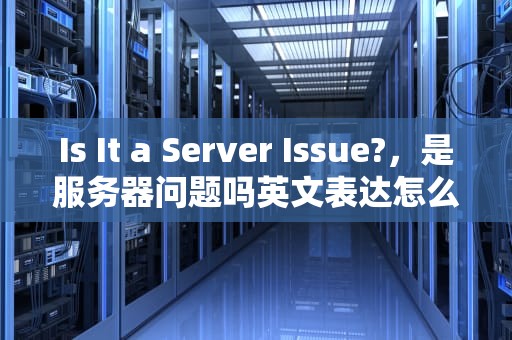In today's digital age, the smooth operation of our online activities heavily relies on servers. Whether you're accessing a website, sending emails, or streaming videos, servers play a crucial role in facilitating these actions. However, when something goes wrong, it often raises the question: "Is it a server issue?" This article aims to delve into the common signs of server problems, their potential causes, and how to troubleshoot them effectively.

Recognizing the Signs of Server Problems
Before diving into solutions, it's essential to identify whether what you're experiencing is indeed related to server issues. Here are some common indicators that might suggest a server problem:
1、Website Downtime: If your website or an application you rely on is not loading at all, a server issue could be the culprit.
2、Slow Performance: Even if the site loads, excessively slow response times can indicate server overload or misconfiguration.
3、Error Messages: HTTP status codes like 500 (Internal Server Error), 502 (Bad Gateway), or 503 (Service Unavailable) directly point towards server-side issues.
4、Email Delivery Failures: If emails sent from your domain are consistently bouncing back with server-related error messages, there might be an issue with your mail server.
5、Frequent Crashes: Applications hosted on a server crashing frequently can signal hardware failures or resource limitations.
6、Unusual Activity Logs: Anomalies in server logs, such as unexpected spikes in traffic or failed login attempts, may indicate security breaches or server stress.
Common Causes of Server Problems
Understanding the root causes of server issues is crucial for effective troubleshooting. Here are some prevalent reasons behind server malfunctions:
1、Hardware Failures: Faulty components like RAM, hard drives, or power supplies can lead to server crashes or data loss.
2、Software Bugs: Operating system glitches, application errors, or outdated software can cause instability and performance issues.
3、Overloading: When a server exceeds its capacity due to high traffic or resource-intensive applications, it can slow down or crash.
4、Network Connectivity Issues: Problems with the network infrastructure, including routers, switches, or ISP outages, can disrupt server communication.
5、Configuration Errors: Incorrect settings in server configuration files or misconfigured databases can lead to functionality issues.
6、Security Threats: Malware infections, DDoS attacks, or unauthorized access can compromise server operations.
7、Maintenance Neglect: Lack of regular updates, backups, and monitoring can leave servers vulnerable to various problems.
Troubleshooting Server Issues
Addressing server problems requires a systematic approach. Here's a step-by-step guide to help you diagnose and resolve common server issues:
1、Check Connectivity: Start by verifying if the issue is local or widespread. Use tools likeping or online uptime checkers to see if the server responds.
2、Review Logs: Server logs provide valuable insights into what might have gone wrong. Look for error messages, unusual patterns, or recent changes that coincided with the issue.
3、Restart Services: Sometimes, simply restarting affected services or the entire server can resolve temporary glitches.
4、Check Resource Utilization: Monitor CPU, memory, and disk usage to identify if the server is overloaded. Adjust资源配置 or optimize applications as needed.
5、Update Software: Ensure that the server's operating system, applications, and security patches are up to date to mitigate known vulnerabilities.
6、Scan for Malware: Run antivirus and antimalware scans to rule out security threats as the cause of the problem.
7、Consult Documentation: Refer to official documentation or community forums for specific error codes or symptoms you encounter.
8、Contact Support: If the problem persists and you're unable to resolve it internally, reach out to your hosting provider or IT support team for assistance.
Preventive Measures
To minimize the occurrence of server problems, consider implementing the following preventive measures:
1、Regular Backups: Schedule frequent backups to safeguard against data loss.
2、Redundancy Planning: Use redundant hardware and network connections to ensure continued operation in case of failure.
3、Load Balancing: Distribute workloads across multiple servers to prevent overloading any single unit.
4、Monitoring Systems: Employ monitoring tools to track server health and receive alerts about potential issues before they escalate.
5、Security Best Practices: Implement strong passwords, firewalls, and regular security audits to protect against cyber threats.
6、Capacity Planning: Regularly assess your server's capacity needs and upgrade resources proactively to handle growth.
In conclusion, while server issues can be frustrating and disruptive, understanding their signs, causes, and troubleshooting methods empowers you to tackle them effectively. By adopting preventive measures and staying vigilant, you can significantly reduce the impact of server problems on your operations and ensure a more stable and reliable online experience. Remember, when in doubt, asking "Is it a server issue?" is the first step towards resolving the mystery behind many tech-related woes.
随着互联网的普及和信息技术的飞速发展台湾vps云服务器邮件,电子邮件已经成为企业和个人日常沟通的重要工具。然而,传统的邮件服务在安全性、稳定性和可扩展性方面存在一定的局限性。为台湾vps云服务器邮件了满足用户对高效、安全、稳定的邮件服务的需求,台湾VPS云服务器邮件服务应运而生。本文将对台湾VPS云服务器邮件服务进行详细介绍,分析其优势和应用案例,并为用户提供如何选择合适的台湾VPS云服务器邮件服务的参考建议。

工作时间:8:00-18:00
电子邮件
1968656499@qq.com
扫码二维码
获取最新动态
